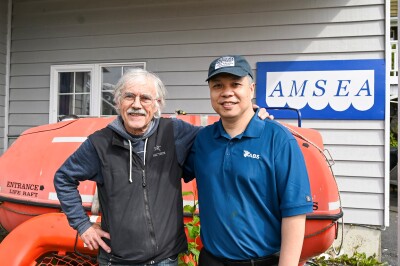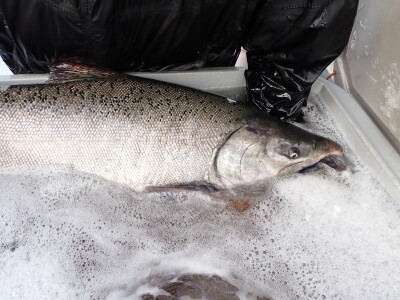Northeast
Martinique gets a Maine boat; P.E.I. lobsterman goes all glass
It was pretty obvious the 39-footer coming out of a bay at H&H Marine in Steuben, Maine, was not the typical lobster boat. Not with the name Rasta Family across its transom.
Then there was the boat's owner Yves Hubert Amable, all 6-foot-7 of him with dreadlocks down to his shoulders. And French, not English, was the spoken language of this fisherman from the island of Martinique in the French West Indies.
Language, however, wasn't a problem for the shorter, undreaded Mainers at the boatyard, because Amable was accompanied by Patrick Henry, another fisherman from Martinique. Henry served as the go-between and translator, since the limited high-school French spoken by H&H Marine's Bruce Grindal wasn't any better than Amable's English.
Henry and Grindal have known each other since the early 1990s when Grindal was general manager at Flye Point Marine, a builder of fiberglass boats in Brooklin, Maine. (It became part of Atlantic Boat Co. in 1995.) Henry had purchased a boat from Flye Point and has been back to Maine since to buy a couple more boats.
"Patrick has been pretty helpful. He knows the lay of the land, where to fly into and where to get hotel rooms," says Grindal, who also describes Henry as a friend.
Since Rasta Family will be used to go longlining, the boat has a large insulated fish hold that's 10 feet long and runs the full width of the deck. Grindal says the hold will pack 17,000 to 18,000 pounds on three- to four-day trips.
In the engine compartment is a Caterpillar C-9 that was detuned to 342 hp to meet permit requirements. Bolted to the back of the Cat is a Twin Disc 5075A marine gear with a 2.5:1 reduction. It turns a 30" x 34" four-bladed prop on a 2 1/4-inch Aquamet shaft. That propulsion package pushed Rasta Family along at 21.6 knots on her April 13 sea trials in nearby Milbridge.
Amable, Henry and Rasta Family left H&H Marine on April 14 to be hauled about an hour south to the Hinckley Co. boatyard in Southwest Harbor. There the boat was transferred to another trailer for the trip to Miami.
Once in Miami, the fuel tanks were topped off with 500 gallons and another 500 gallons was stored on deck. The trip to Martinique was scheduled to take five to seven days with a stop in Puerto Rico for fuel.
Even with the cost of getting the boat from Maine to the French West Indies, Grindal says, "We are competitively priced compared to buying the boat in France, which is where they purchase a lot of stuff."
In Martinique, a couple of local fishermen were scheduled to go out on Rasta Family and then call Grindal and talk about having a boat built.
Across the Canadian border and up on Prince Edward Island, Provincial Boat and Marine in Kensington launched a 45-footer on May 6 for David Doucette, a Prince Edward Island lobsterman from Rustico.
Doucette had been fishing from a wooden boat covered with fiberglass, but that recently burned.
There's very little wood on Doucette's new boat. "The only thing that's wood is the bathroom door and a couple of cupboards. We never build with wood," says Provincial's Gordon Campbell.
The Marley Marie's hull is solid fiberglass, as are the deck, wheelhouse and cuddy cabin. The deck is supported by transverse and longitudinal bulkheads made of 2-inch-thick foam covered with fiberglass.
For power Doucette's boat has a 430-hp Cummins C-series diesel coupled to a ZF 301 marine gear with a 2.694:1 reduction. The four-bladed prop measures 30" x 30".
Provincial is completing two more 45-footers for commercial fishermen. One is going to Florida and the second to Barbados. Campbell says he sent a 42-footer to Barbados a few years ago, and a fisherman saw the boat, liked it, and ordered himself the 45-footer.
Barbados isn't far from Martinique, where the H&H Marine–built boat is going, but instead of being trailered first to Miami, Provincial's 45-footer "will be sailed from here," Campbell says. After passing through Nova Scotia's Canso locks, she'll head out into the Atlantic for Bermuda, then stop at the island of St. Martin before pointing toward Barbados. Not bad for a boat most people consider is limited to inshore lobstering. — Michael Crowley
WEST
Gillnetters choose low power; more boats go to Copper River
In May Petrzelka Bros. in Mount Vernon, Wash., usually launches a couple of new salmon gillnetters for Alaska, and this year was no exception. The boatshop had finished off two hulls that were due to go in the water by the second week of the month.
Both boats are wheelhouse-forward designs. One is a 37-foot fiberglass Wegley hull that is going to False Pass, and the other a 32-foot aluminum Baycraft headed for Bristol Bay. Both boats are for Washington fishermen. The 37-footer is for Alan Melling and the 32-footer is going to LeRoy Cossett.
Melling gets a larger gillnetter because the False Pass fishery, unlike Bristol Bay, doesn't have a boat-length limit. This is more of an open ocean fishery, so a larger boat comes in handy in the rougher conditions.
Another benefit of a bigger boat is additional hold capacity. Thus Melling's boat has 12 holds for brailer bags, while the smaller 32-footer has eight holds. Both gillnetters have refrigerated seawater systems for chilling down the fish.
The two gillnetters have hulls that can get up and run, but in this case the boats' owners have opted for a single 275-hp John Deere engine. Before the sea trials, the boatshop's Jon Petrzelka estimated both boats would probably be in the 12-knot speed range.
"These won't be fast boats, but they will be economical. It's not like the old boats where they put 700 to 800 horsepower in. It's not in that ball game anymore. Speed's not near as important; burn a whole bunch more fuel, do a lot of running around and the bottom line is you might not catch any more fish," Petrzelka says.
The crew at Petrzelka Bros. heads up to Cordova, Alaska, and the Copper River to do their own salmon gillnetting each year, but before they could pack up and leave there were a couple of small projects to finish up. One was to put a new gantry on a 36-foot boat used for ecological surveying, and the second was to check out the systems on a Bristol Bay gillnetter.
For next year, Petrzelka Bros. has a 31-foot fiberglass hull to finish off as a gillnetter.
In Alaska's Copper River salmon fishery, gillnetters buying a new boat are not shunning the high horsepower option. Hard Drive Marine in Bellingham, Wash., (it used to be called TommyCraft) has only been in operation for a little more than a year, but in May it was finishing its sixth aluminum gillnetter. All six have had twin engines and twin water jets.
All but one of the boats has twin GM 496 big-block gasoline engines matched up to Hamilton 241 jets. The exception is a gillnetter outfitted with a pair of Volvo D6 diesels that are also powering Hamilton 241 jets.
Most gillnetters looking for speed shy away from diesels because they are heavier than gasoline engines and more expensive. The boatshop's Tom Day estimates that a pair of the gasoline engines costs $20,000, while the twin diesels run between $54,000 and $60,000.
"The new Volvo D6 is heavy, but it's a marine platform," Day says. "It's not a truck engine converted to marine, and it turns the rpms. It got up to 3,575 rpms with a Hamilton 241."
Day adds when the Volvo-powered gillnetter was sea trialed in Bellingham, he was in a pursuit boat that was making 34 knots, "and it was walking away from me."
The gillnetters that Hard Drive Marine builds are "pretty much sisterships," Day says. He did the original design, which features a reverse chine that runs all the way from the transom to the bow.
So far, Hard Drive Marine only does the aluminum work on the boats. "A lot of guys want to save money and do the work themselves," explains Day, who says he expects the shop will soon
be getting into "turnkey situations."
By mid-May, Day and his crew started their seventh gillnetter. Two more gillnetters will be started between May and early fall. Day also says he would like to build some seine skiffs for Prince William Sound.
Down in Oregon, Sundial Marine Construction & Repair has a couple of large boats in for general maintenance. The Argosy and the Alsea, both 120 feet, were hauled to have the hulls sandblasted and painted. The Alsea is also having some bulwark work done. — Michael Crowley
SOUTH
Ala. yard's forte is scallopers; a tug joins the menhaden fleet
In 1975, the La Force family started La Force Shipyard in Bayou La Batre, Ala., primarily to build commercial fishing boats for the Gulf of Mexico shrimp fishery. The most notable change over the years is the yard's name. Since 2005 La Force Shipyard has been known as Raymond & Associates, named after Raymond La Force, the boatyard's owner and manager. And, yes, you are much more likely to find them building scallop boats than gulf shrimpers.
Currently under construction at Raymond & Associates is the Andrea A, a 79' 8" x 26' x 12' steel scalloper being built for Warren Alexander.
Alexander owns Atlantic Shellfish in Cape May, N.J. The company owns 17 fishing boats, as well as several 135-foot offshore supply vessels that service the oil industry in the Gulf of Mexico.
Alexander, 57, has been working in the commercial fishing business since he was 13 years old and has boats working up and down the Atlantic coast.
He obviously has faith in the workmanship of the crew at Raymond & Associates, as the boatyard has build Alexander four new scallopers, converted five shrimp boats into scallopers and constructed three oil supply boats.
In December of 2008, Raymond & Associates launched the Karen Nicole, a sistership to the Andrea A. The Karen Nicole is currently working in the scallop fishery.
The Andrea A is about half completed. A 3508 Caterpillar that delivers 750 hp at 1,200 rpm will be her source of propulsion. Behind the Cat is a Twin Disc marine gear with a 5:1 reduction.
The hydraulics will run off a 450-hp John Deere, and two John Deere 63-kW generators will provide electrical service to the boat.
At the same time Raymond & Associates is building the Andrea A, Alexander has another Bayou La Batre boatyard, Jemison Marine & Shipbuilding, converting a 93' x 25' x 12' shrimp boat into a scalloper.
Alexander bought the repossessed shrimper from a bank and is having Tim Jemison of Jemison Marine do the conversion. The work includes installing booms and gallows, new hydraulics and a haul-back station atop the house.
"Over the years, we've had Jemison do right much work for us," says Alexander. "Both these yards do very good work, and a good sign of a successful boatyard is when a customer, like me, keeps coming back."
In 2005, Jimmy Kellum of Ocean Bait in Weems, Va., completely rebuilt the 1950 menhaden boat Absecon and renamed it Carters Creek. He has worked the boat for four years in Chesapeake Bay's snapper menhaden fishery.
The Carters Creek holds a lot of fish — so much so that Kellum was losing too much fishing time tied to the dock off-loading his catch. Recently, he purchased the Gettysburg, a 107-foot tugboat built in 1972. He has completely refurbished it into a carry-away boat for menhaden fishing.
The Gettysburg can either harvest menhaden or transport the catch of the Carters Creek to the dock, which allows the Carters Creek crew to continue fishing.
Kellum did most of the designing for the conversion and the construction work himself. He renamed the boat Indian Creek. Ampro Shipyard in Weems, Va., and Best Repair Co. of Norfolk, Va., helped with metalwork on the boat.
Indian Creek is expected to carry 270,000 pounds of menhaden. A 16V-149 Detroit Diesel rated for 1,000 hp at 1,850 rpm will power the boat. The Detroit will work through a 6:1 marine gear and turn a 92" x 62" three-blade prop. Two 60-kW generators have been installed. The freezers will use an 8-cylinder Vilter ammonia refrigeration compressor.
The hull plating was ultrasounded and the entire bottom was found to be no less than a half-inch thick. A cage was built around the wheel and the 12' x 6' rudder. Thrusters were installed in the Indian Creek's bow and stern areas.
Kellum will experiment with the boat by fishing it without a purse boat. Large menhaden factory steamers use two purse boats, while snapper rigs, like Kellum's, use only one purse boat. Both use power blocks to harden up the net.
Kellum says if he can figure out how to fish without purse boats it would cut the crew down to five and eliminate the expense of purse boats. — Larry Chowning






